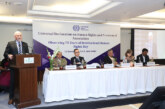 After a brief respite with relatively clean air over the last two days, city’s air quality slipped to “very poor” zone on Monday. Despite favourable weather conditions such as wind speed, temperatures and Relative Humidity (RH), noxious pollutants were recorded high in various monitoring agencies.
After a brief respite with relatively clean air over the last two days, city’s air quality slipped to “very poor” zone on Monday. Despite favourable weather conditions such as wind speed, temperatures and Relative Humidity (RH), noxious pollutants were recorded high in various monitoring agencies.
The Central Pollution Control Board’s (CPCB) National Air Quality Index had Delhi in the ‘very poor’ zone with a score of 326. It was in ‘moderate’ zone with a score of 292 on Sunday and 298 on Saturday. System of Air Quality Forecasting and Research (SAFAR), a unit of Ministry of Earth Sciences (MoES) also marked city’s air quality “Red” on pollution index.
Experts attributed sudden deterioration of air quality to the impact of sporadic drizzle in flushing out pollutants ebbed and more vehicles hit the streets on the first working day of the week.
According to environment experts, more than Delhi, areas surrounding the national Capital received drizzle helping wash away the accumulated particulates. That was the reason the city enjoyed the season’s best quality air over the last two days.
“But now the impact of rain is slowly diminishing. Temperature levels have dropped and moisture has also marginally increased. The current air quality is a play of those meteorological conditions and emissions from internal sources,” SAFAR project director Gufran Beig said.
Pollution forecasters institutions have emphasised that the city’s air quality will remain in the ‘very poor’ category and chances of it deteriorating further in the coming days is less as incursion of pollutants from external sources has stopped.
An AQI value between 301 and 400 is classified as ‘very poor’. Prolonged exposure to such air quality may trigger respiratory illness, the CPCB says.
He said the level of pollutants would show some increase over the next two days but air quality was not likely to turn ‘severe’ in the AQI scale.
Incursion of emissions from external sources such as paddy stubble burning has stopped and the wind direction has also turned north-westerly, which is bringing cold wave from the upper Himalayas.
SAFAR recorded the average values of PM2.5 and PM10 at 154 and 243 micrograms per cubic metre, as against the prescribed standards 60 and 100.
PM2.5 and PM10 are descriptions for ultrafine particulates which remain suspended in the air and enter the respiratory system with inhalation, causing a host of complications, both pulmonary and cardiovascular.



